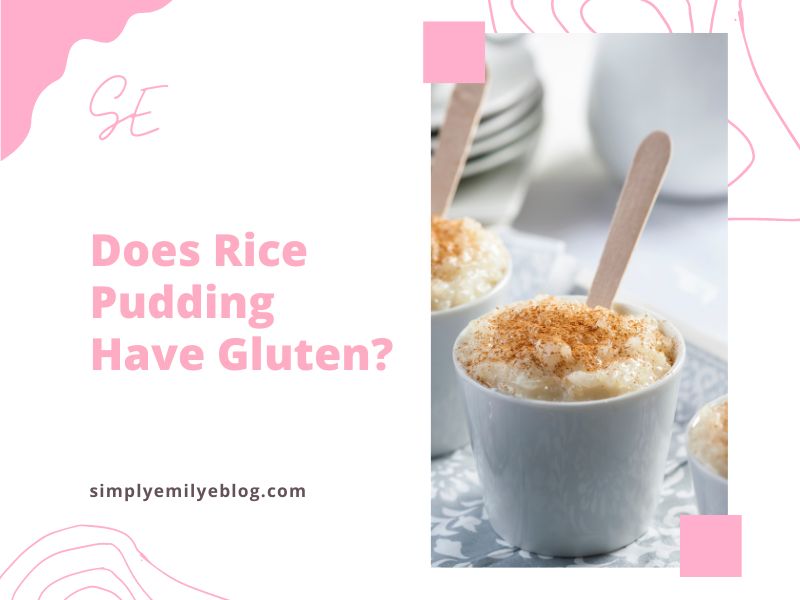So you’re wondering – does rice pudding have gluten? Gluten is a type of protein found in certain grains such as wheat, rye and barley. People with celiac disease must avoid eating foods that contain gluten, as even a small amount can damage the small intestine and prevent the absorption of important nutrients.
- But what about rice pudding? Does rice pudding have gluten?
- Does rice pudding have wheat?
- Wheat-containing ingredients in rice pudding
- Is rice pudding gluten free?
- Does rice pudding naturally contain gluten?
- What are the common sources of gluten in rice pudding?
- Can rice pudding be made gluten-free?
- Is store-bought rice pudding gluten-free?
- What ingredients should I look out for to ensure gluten-free rice pudding?
- Can I use alternative grains in rice pudding to avoid gluten?
- Is homemade rice pudding gluten-free?
- Can cross-contamination occur when making rice pudding at home?
- Are there pre-packaged gluten-free rice pudding options available?
- Can I make rice pudding without milk to avoid lactose or dairy?
- How can I make sure the rice pudding I order at a restaurant is gluten-free?
- Can rice pudding be enjoyed as part of a gluten-free diet?
- What are some gluten-free toppings I can enjoy with rice pudding?
- Can rice pudding be frozen for later consumption?
But what about rice pudding? Does rice pudding have gluten?
In short, the answer is no. Rice pudding usually contains just two ingredients: rice and milk. Neither of these contain gluten, so you can safely enjoy a bowl of rice pudding as part of a gluten-free diet.
However, if you buy pre-made rice pudding from the store, it might contain gluten-containing ingredients like wheat-based thickeners, flavoring extracts, or food coloring. Make sure to read the label or contact the manufacturer if you’re unsure.
Now that you know the answer to your original question – does rice pudding have gluten – let’s take a closer look at why this popular dessert can be part of your gluten-free diet.
| Ingredient | Gluten Content |
|---|---|
| Rice | Gluten-free |
| Milk | Gluten-free |
| Sugar | Gluten-free |
| Vanilla Extract | Gluten-free |
| Cinnamon | Gluten-free |
| Nutmeg | Gluten-free |
| Raisins | Gluten-free |
| Almonds | Gluten-free |
| Condensed Milk | May contain gluten |
| Flour (used as a thickener) | Contains gluten |
| Barley (added for flavor) | Contains gluten |
| Malt (used as a sweetener) | Contains gluten |
| Oats (added for texture) | May contain gluten |
Rice pudding has been enjoyed around the world for centuries – in fact, it’s one of the oldest recipes known to man. It’s made by boiling milk (usually cow’s milk), sugar, and cream with rice and has been enjoyed by cultures everywhere. This simple combination has evolved into many other variants, such as the popular Spanish version, ‘arroz con leche’, and the British and American favorite, ‘rice pudding’.
Rice pudding is unique among gluten-free desserts because it contains two ingredients that are naturally gluten-free: rice and milk. Other common gluten-free desserts, like cakes and cookies, often require alternative flours such as almond flour, which may be hard to find or expensive. Rice pudding is a budget friendly alternative that is easy to make and still flavorful.
If you want to discover more about Wendy’s coffee, I just wrote an amazing article. Take a look whenever you have a moment.
Rice pudding is a great gluten-free choice if you’re looking for a comforting dessert. It’s creamy and sweet, and can be enjoyed warm or cold. It pairs perfectly with another gluten-free favorite, fresh fruit.
My personal favorite way to enjoy rice pudding is to top it with crunchy almonds and raisins or a scoop of dairy-free ice cream. It’s a simple and delicious way to end your meal on a sweet note.
Does rice pudding have wheat?
Now, there’s nothing quite like a good rice pudding. Velvety-smooth, delicately flavored and lightly sweetened, it’s a classic comfort food. But what about wheat? Does rice pudding have wheat? Let’s find out!
Rice pudding is a custard-style dish made with milk, eggs, sugar, and cooked rice. The variations can be endless; some recipes call for added spices, fruits or nuts for flavor, while others may opt for a chocolate twist. Traditional rice pudding typically does not contain wheat, because no wheat-based ingredients are required. However, in some recipes, wheat-based ingredients are added for texture and flavor, like wheat germ, wheat flour, or wheat toast.
Wheat germ is a valuable source of vitamin E, thiamin, zinc, and protein. While it can add nutty and earthy flavors to rice pudding, it is definitely a wheat-based ingredient. The same goes for wheat flour, which is another traditional ingredient used to thicken some types of rice pudding. But if you’re looking for a wheat-free dessert, be sure to omit them.
Wheat-containing ingredients in rice pudding
Wheat-containing ingredients like wheat toast are occasionally added for texture and crunch. Wheat toast can provide a nice coating around each spoonful of rice pudding, giving it an added crunch. And interestingly enough, it can add a mild sweetness to it, too. If you’re not a fan of adding wheat products to your rice pudding, simply omit it from your recipe.
My own experience making homemade rice pudding has been a great one. I love the traditional, not-too-sweet comforting flavor of it. One of my favorite recipes is for traditional rice pudding, which entails cooking the pudding with milk, sugar, and cooked rice. It’s a classic recipe that never fails to simultaneously soothe and satisfy.
In search of a quick and easy pudding fix, I have also ventured into the microwaved version. While it does require a few wheat-based ingredients, like breadcrumbs and wheat germ, it is a delicious, ready-in-minutes dessert. I like to top it with a sprinkle of nutmeg for a hint of extra flavor.
Overall, it is up to you whether or not you want to add wheat-based ingredients to your rice pudding. If you’re looking specifically for a wheat-free version, I would suggest sticking with a traditional recipe. But for something simple and speedy, the microwaved version just might be the ticket!
But guess what! If you’re curious about the number of jalapenos needed to fill a pound, I’ve written a fantastic article on that. Whenever you can, give it a read.
So, does rice pudding have wheat? The answer is not straightforward, as traditional rice pudding does not contain wheat. However, some recipes do call for some wheat-based ingredients, like wheatgerm, wheat flour, and wheat toast. But if you’d prefer to avoid wheat products altogether, just stick to a traditional recipe. And for a quick and convenient fix, try the microwaved version.
Is rice pudding gluten free?
Most important questions for a gluten-sensitive people tend to revolve around what is safe to eat and what is not safe to eat. This usually means going to great lengths to ensure the ingredients used in their recipes are gluten-free, and as a result, many people want to know if rice pudding is gluten-free.
The answer is a resounding yes: rice pudding is typically gluten-free, as long as you use gluten-free ingredients and make sure that cross-contamination is avoided. However, I will explain how to make sure you make a truly gluten-free rice pudding, why it is gluten-free, and provide a few of my favorite recipes!
To begin with, rice pudding is naturally gluten-free as both white and brown rice are grains that are naturally gluten-free. Additionally, most of the ingredients used in a traditional rice pudding are also gluten-free. These include milk, cream, sugar, and butter – all of which do not contain any gluten.
The only ingredient that may contain gluten is the flavoring, such as vanilla extract or cinnamon, so it is important to check the label and make sure it does not contain any wheat-based products.
It is also essential to make sure all of the ingredients are certified or tested to be gluten-free, as cross-contamination is a real issue to be aware of. Cross-contamination can occur when a separate utensil is not used to stir the ingredients or if someone in contact with the ingredients has gluten-containing ingredients on their hands.
To avoid this, I always make sure to use separate implements when stirring and always make sure to thoroughly wash hands in between handling gluten-containing products and gluten-free products.
Now that we have the basics down, we can start discussing all of the different types of rice pudding available to make, and how to customize them further. First off, what type of rice should you use when making a gluten-free rice pudding? It honestly doesn’t matter whether you use white or brown rice, as long as the rice you use is certified gluten-free. I usually prefer to use white rice when making my rice pudding because it has a milder and sweeter taste and is also easier to find gluten-free.
As for the type of milk you should use, I usually recommend using whole milk or coconut milk to get the most flavor and texture, but any type of milk should work. The only difference in taste and texture between different milks will be in the finished product. Hold on! In case you’re intrigued by peanut butter and honey sandwiches, I just wrote a fantastic article. Take a look whenever you have a moment.
Evaporated milk, cream, or a combination of the two can also be used to get an extra creamy texture. If you’d like an extra indulgent rice pudding, you can substitute half and half for the milk and even add some cream cheese.
Now, when it comes to the flavor, this is completely up to you. Vanilla extract is a classic ingredient when making rice pudding and I usually add cinnamon or nutmeg whenever I make it as well. However, you can substitute different extracts and spices, depending on your preferences.
My favorite type of rice pudding is a tropical version that I make with coconut milk, pineapple, banana, and macadamia nuts. But feel free to try out different combinations and find one that works for you and your family. Or why not make a savory rice pudding?
A delicious and simple option is to just replace some of the sugar with savory ingredients like bacon, rosemary, cheddar cheese, or all of the above! The options are endless, just be creative with it.
Does rice pudding naturally contain gluten?
No, rice pudding itself does not naturally contain gluten. The primary ingredients – rice, milk, and sugar – are all gluten-free. However, it’s essential to be aware of potential gluten-containing additives or cross-contamination during preparation.
What are the common sources of gluten in rice pudding?
Gluten can potentially be present in rice pudding if certain ingredients or additives are used. Some common sources of gluten include flavorings, extracts, thickeners, and toppings like crumbled cookies or biscuits. I’ve written a superb article that explores the calories in rice and beans. Check it out at your convenience.
Can rice pudding be made gluten-free?
Rice pudding can be easily prepared in a gluten-free manner. By using gluten-free ingredients and being mindful of potential cross-contamination, you can create a delicious gluten-free rice pudding that satisfies your cravings.
Is store-bought rice pudding gluten-free?
Not all store-bought rice pudding options are gluten-free. Some commercially prepared rice puddings may contain additives or ingredients that contain gluten. It’s essential to carefully read the ingredient labels or look for specific gluten-free labeling on the packaging.
What ingredients should I look out for to ensure gluten-free rice pudding?
When purchasing or making rice pudding, it’s crucial to scrutinize ingredient labels. Look out for potential gluten-containing ingredients such as wheat, barley, rye, malt, or any derivatives of these grains. Choosing gluten-free versions of flavorings and toppings is also important.
Can I use alternative grains in rice pudding to avoid gluten?
Rice pudding offers a wonderful canvas for culinary experimentation. You can explore gluten-free alternatives such as using quinoa, millet, or gluten-free oats as a substitute for rice, creating a unique twist on this classic dessert.
Is homemade rice pudding gluten-free?
Homemade rice pudding can be gluten-free if you use gluten-free ingredients and maintain a gluten-free cooking environment. By carefully selecting your ingredients and ensuring a dedicated gluten-free preparation process, you can savor a delightful homemade gluten-free rice pudding.
Can cross-contamination occur when making rice pudding at home?
Cross-contamination is a potential concern when preparing gluten-free rice pudding at home. It’s important to use separate utensils, cookware, and preparation surfaces to prevent any inadvertent contact with gluten-containing ingredients.
Are there pre-packaged gluten-free rice pudding options available?
Yes, there are pre-packaged gluten-free rice pudding options available in many specialty food stores or online. These products are specifically formulated and tested to be gluten-free, providing a convenient and safe option for individuals with gluten sensitivity or celiac disease.
Can I make rice pudding without milk to avoid lactose or dairy?
Yes! If you need to avoid lactose or dairy, rice pudding can be made using alternative milk options such as almond milk, coconut milk, or oat milk. These dairy-free alternatives provide a delicious and creamy base for your gluten-free rice pudding.
How can I make sure the rice pudding I order at a restaurant is gluten-free?
When dining out, it’s crucial to communicate your dietary needs clearly to the restaurant staff. Inquire about the ingredients and preparation methods of their rice pudding. Ask if they can accommodate gluten-free requests or if they have a dedicated gluten-free menu.
Can rice pudding be enjoyed as part of a gluten-free diet?
Rice pudding can be a delightful addition to a gluten-free diet. With careful ingredient selection, homemade preparation, or choosing trusted gluten-free options, you can enjoy the creamy goodness of rice pudding without compromising your dietary needs.
What are some gluten-free toppings I can enjoy with rice pudding?
There are numerous gluten-free toppings you can indulge in with rice pudding. Fresh fruits, toasted nuts, shredded coconut, or a drizzle of gluten-free caramel or chocolate sauce can add a delightful touch to your gluten-free rice pudding experience.
Can rice pudding be frozen for later consumption?
Yes, rice pudding can be frozen for later enjoyment. Ensure you use airtight containers or freezer bags to maintain its quality. Thaw it in the refrigerator and give it a gentle stir before serving to restore its creamy texture.




